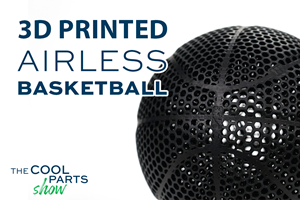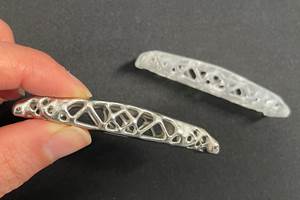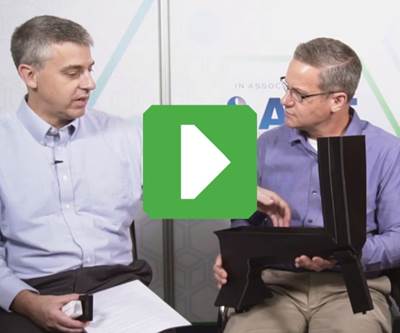Video: Selective Laser Sintering for Production of Large Parts
SLS offers a production option enabling large, precise plastic parts to be made cost-effectively in quantities generally too low for injection molding.
A challenge of large, intricate plastic parts is that they have tended to demand large production quantities. Only large quantities can justify the mold tooling required. But Chuck Kennedy, VP of operations with additive manufacturing machine maker Farsoon, says advances in selective laser sintering (SLS) have made it competitive with injection molding in precision and quality. For large plastic parts such as the HVAC component seen on this page, 3D printing via SLS now offers a production option allowing the part to be made cost-competitively in quantities of 50,000 or less rather than the hundreds of thousands that the economics of injection molding would require. Kennedy and I recently talked about SLS as an alternative to molding for large parts.
Transcript
Peter Zelinski, Additive Manufacturing
Chuck, you brought in a really big part here. What is this?
Chuck Kennedy, Farsoon Technologies
It's a selective laser sintering (SLS) part built in our new model HT1001P. This is our standard nylon PA12 material that we make at our factory as well, so we manufacture the material as well as the machines.
Peter Zelinski
This is an HVAC component.
Chuck Kennedy
Yes, it's a HVAC component for one of our partners in China but it's a global company and they just happen to be manufacturing the HVAC components there. It used to be that this was a molding application.
Peter Zelinski
It was formally injection molded in in all one piece like this.
Chuck Kennedy
No, it was probably about a two- or three-piece mold. They consolidated it through design.
You can see that there's a lot of hidden channels, undercuts, those type of things. All of those things require some level of tooling. They were able to simplify some of that design. Then, through additive, they're able to do this in one piece. This piece was done in about 10 hours.
Peter Zelinski
Do you know why the manufacturer arrived at 3D printing as the alternate process for this part? Was there a particular challenge with this component when it was molded or was it a particularly difficult part?
Chuck Kennedy
When you look at general tooling injection molding, you've got to amortize the cost of those tools over time. If you're looking at a tool that maybe costs $500,000 to do, you've got to amortize that over many components and it ends up being a million-component type of amortization. They may not have a car with that life cycle but they're going to sell that many units. That's how they derived that per piece aspect of the cost.
We've got a limited volume of these cars and we only need 50,000 of these parts over the next five years or three years. Do we want to spend this amount on tooling or produce the part in additive? [This] also allows them to come back into making slight design changes and they can make those changes on the fly and improve things.
Peter Zelinski
Those who are familiar with additive are not surprised by the complexity of this part. We're very familiar with seeing complex parts made additively, but we're not necessarily familiar with additive being made for a production part or part at this scale. Let's talk about the size first. Are there technology advances or improvements that have made it practical to do SLS for a part this big?
Chuck Kennedy
Yeah, it kind of starts with the scanners and the lasers. There are some technical advantages with scanning systems and selective laser sintering because of the accuracy of the galvo systems. It allows you to meet accuracies that you normally would only get out of injection molding. When you're talking about those levels and this is scalable to the point where we could add four lasers, eight lasers, eight scanners to really scale this up for larger production as well.
Peter Zelinski
You mentioned tens of thousands of units perhaps. What does the additive manufacturing system or platform look like that takes apart like this and repetitively produces at production scale?
Chuck Kennedy
Picture a conveyor belt system. This system alone has a pre-heat station. You have your cartridge in there that's been preheated. Then, you have your build station. After [that] finishes it moves over to an automated cooling station. Then, it allows the next chamber to come into the build station already preheated and then starts up your next build. It truly gets to that point where you're doing chain production.
Peter Zelinski
What is your sense of what that will mean? This is 3D printing as an alternative to injection molding. How far can 3D printing go as a production process for parts like this?
Chuck Kennedy
The big gap there is the raw material cost. Additive materials are still at a point where the per kilo price of powders is significantly higher than pellets, for instance. The initial phases are going to really be designed around custom, limited quantities. Picture some of the custom cars that are out there that they're only going to [make] 1,000 cars. When you talk about things like widgets or gears or those types of things, you take something that requires three or four parts to be screwed together. Now through additive you can do it in one part, and you can fit a thousand of them onto a build tray. There's your value in getting out of that injection molding side. But, big parts like this? It's going to be in the low volume, highly complex parts.
Related Content
Airless Basketball Shows Promise of 3D Printed Lattices: The Cool Parts Show Bonus
Successfully matching the performance of a standard basketball demonstrates the control possible over the mechanical properties of digital materials.
Read MoreLarge-Format “Cold” 3D Printing With Polypropylene and Polyethylene
Israeli startup Largix has developed a production solution that can 3D print PP and PE without melting them. Its first test? Custom tanks for chemical storage.
Read MoreActivArmor Casts and Splints Are Shifting to Point-of-Care 3D Printing
ActivArmor offers individualized, 3D printed casts and splints for various diagnoses. The company is in the process of shifting to point-of-care printing and aims to promote positive healing outcomes and improved hygienics with customized support devices.
Read MorePossibilities From Electroplating 3D Printed Plastic Parts
Adding layers of nickel or copper to 3D printed polymer can impart desired properties such as electrical conductivity, EMI shielding, abrasion resistance and improved strength — approaching and even exceeding 3D printed metal, according to RePliForm.
Read MoreRead Next
Farsoon Technologies’ Large-Volume Polymer 3D Printer Debuts in U.S.
The HT1001P, Farsoon's new large-volume polymer 3D printer, is set to be beta tested by two U.S. companies later this year. The system will eventually offer three tiers of automated production.
Read MoreVideo: The Pella Corporation Is Succeeding With 3D-Printed Tooling
An engineering leader with the window and door maker shows examples of the tooling and machine parts now produced for the company's manufacturing processes using 3D printing.
Read MoreHybrid Additive Manufacturing Machine Tools Continue to Make Gains (Includes Video)
The hybrid machine tool is an idea that continues to advance. Two important developments of recent years expand the possibilities for this platform.
Read More




















